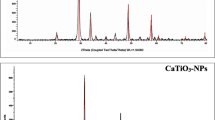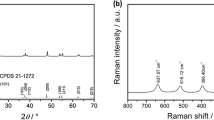Abstract
Titanium dioxide (TiO2) nanoparticle is an important product for nanotechnology because of its high stability, anticorrosion, and photocatalysis. It is also used in cosmetic and skin care products, particularly in sunblocks, where it helps to protect the skin from UV light, especially in the case of nanosized particles (<100 nm). There are extensive concerns on the potential risks of TiO2 nanoparticle to human health and environment. Some forms at least may be genotoxic, photocatalytic, and/or carcinogenic. In this study, we have characterized the physico-chemical properties of commercially available photocatalytic TiO2 nanoparticle and compared to cellular effects in HaCaT Cells with or without photoactivation. The present study has shown that TiO2 nanoparticles are cytotoxic to HaCaT cells even in the absence of photoactivation. This effect became more pronounced in the simultaneous irradiation of UVA dependent on photocatalytic potential of TiO2 nanoparticle. We also found that the cytotoxicity and oxidative stress of TiO2 nanoparticles strongly depends on physico-chemical properties including structure (anantase, rutile, or mixture) or photocatalytic potency of TiO2 nanoparticles.
Similar content being viewed by others
References
Trouiller, B. et al. Titanium dioxide nanoparticles induce DNA damage and genetic instability in vivo in mice, Cancer Res 69:8784–8789 (2009).
Lomer, M. C., Thompson, R. P. & Powell, J. J. Fine and ultrafine particles of the diet: influence on the mucosal immune response and association with Crohn’s disease. Proc Nutr Soc 61:123–130 (2002).
Gelis, C. et al. Assessment of the skin photoprotective capacities of an organo-mineral broad-spectrum sunblock on two ex vivo skin models. Photodermatol Photoimmunol Photomed 19:242–253 (2003).
Baan, R. et al. Carcinogenicity of carbon black, titanium dioxide, and talc. Lancet Oncol 7:295–296 (2006).
Fryzek, J. P. et al. A cohort mortality study among titanium dioxide manufacturing workers in the United States. J Occup Environ Med 45:400–409 (2003).
Johnston, H. J. et al. Identification of the mechanisms that drive the toxicity of TiO2 particulates: the contribution of physicochemical characteristics. Part Fibre Toxicol 6:1–27 (2009).
Lam, C. W., James, J. T., McCluskey, R. & Hunter, R. L. Pulmonary toxicity of single-wall carbon nanotubes in mice 7 and 90 days after intratracheal instillation. Toxicol Sci 77:126–134 (2004).
Peters, K. et al. Effects of nano-scaled particles on endothelial cell function in vitro: studies on viability, proliferation and inflammation. J Mater Sci Mater Med 15:321–325 (2004).
Yamamoto, A., Honma, R., Sumita, M. & Hanawa, T. Cytotoxicity evaluation of ceramic particles of different sizes and shapes. J Biomed Mater Res 68A:244–256 (2004).
Zhang, Q. et al. Differences in the extent of inflammation caused by intratracheal exposure to three ultrafine metals: role of free radicals. J Toxicol Environ Health A 53:423–438 (1998).
Rahman, Q. et al. Evidence that ultrafine titanium dioxide induces micronuclei and apoptosis in Syrian Hamster embryo fibroblasts. Environ Health Perspect 110:797–800 (2002).
Gurr, J., Wang, A. S. S., Chen, C. & Jan, K. Ultrafine titanium dioxide particles in the absence of photoactivation can induce oxidative damage to human bronchial epithelial cells. Toxicology 213:66–73 (2005).
Wang, J. J., Sanderson, B. J. S. & Wang, H. Cyto- and genotoxicity of ultrafine TiO2 particles in cultured human lymphoblastoid cells. Mutat Res 628:99–106 (2007).
Long, T. C. Titanium dioxide produces reactive oxygen species in immortalized brain microglia: Implications for nanoparticle neurotoxicity. Environ Sci Technol 40:4346–4352 (2006).
Carinci, F. et al. Titanium-cell interaction: analysis of gene expression profiling. J Biomed Mater Res 66B: 341–346 (2003).
Bermudez, E. et al. Pulmonary responses of mice, rats, and hamsters to subchronic inhalation of ultrafine titanium dioxide particles. Toxicol Sci 77:347–357 (2004).
Zhang, A. & Sun, Y. Photocatalytic killing effect of TiO2 nanoparticles on Ls-174-t human colon carcinoma cells. World J Gastroenterol 10:3191–3193 (2004).
Nakagawa, Y., Wakuri, S., Sakamoto, K. & Tanaka, N. The photogenotoxicity of titanium dioxide particles. Mutat Res 394:125–132 (1997).
Linnainmaa, K., Kiveipensa, P. & Vainio, H. Toxicity and cytogenetic studies of ultrafine titanium dioxide in cultured rat liver epithelial cells. Toxicol in Vitro 11:329–335 (1997).
Agrios, A. G. & Pichat, P. State of the art and perspectives on materials and applications of photocatalysis over TiO2. J Appl Electrochem 35:655–663 (2005).
Herrmann, J. M. Heterogeneous photocatalysis: fundamentals and applications to the removal of various types of aqueous pollutants. Catal Today 53:115–129 (1999).
Serpone, N., Dondi, D. & Albini, A. Inorganic and organic UV filters: Their role and efficacy in sunscreens and suncare products. Inorg Chim Acta 360:794–802 (2007).
Brezova, V. et al. Reactive oxygen species produced upon photoexcitation of sunscreens containing titanium dioxide (an EPR study). J Photochem Photobiol B: Biology 79:121–134 (2005).
Dunford, R. et al. Chemical oxidation and DNA damage catalysed by inorganic sunscreen ingredients. FEBS Lett 418:87–90 (1997).
Uchino, T., Tokunaga, H., Ando, M. & Utsumi, H. Quantitative determination of OH radical generation and its cytotoxicity induced by TiO2-UVA treatment. Toxicol In Vitro 16:629–635 (2002).
Sayes, C. M. et al. Correlating nanoscale titania structure with toxicity: A cytotoxicity and inflammatory response study with human dermal fibroblasts and human lung epithelial cells. Toxicol Sci 92:174–185 (2006).
Hidaka, H. et al. DNA damage photoinduced by cosmetic pigments and sunscreen agents under solar exposure and artificial UV illumination. J Oleo Sci 55:249–261 (2006).
Anderson, D. & Plewa, M. J. The international comet assay workshop. Mutagenesis 13:67–73 (1998).
Fairbairn, D. W., Walburger, D. K., Fairbairn, J. J. & O’Neill, K. L. Key morphologic changes and DNA strand breaks in human lymphoid cells: discriminating apoptosis from necrosis. Scanning 18:407–416 (1996).
Speit, G. & Hartmann, A. The comet assay (single-cell gel test). A sensitive genotoxicity test for the detection of DNA damage and repair. Methods Mol Biol 113:203–212 (1999).
Kawahara, T. et al. Photocatalytic activity of rutileanatase coupled TiO2 particles prepared by a dissolution-reprecipitation method. J Colloid Interf Sci 267: 377–381 (2003).
Reeves, J. F., Davies, S. J., Dodd, N. J. F. & Jha, A. N. Hydroxyl radicals (OH) are associated with titanium dioxide (TiO2) nanoparticleinduced cytotoxicity and oxidative DNA damage in fish cells. Mutat Res-Fund Mol M 640:113–122 (2008).
Theogaraj, E. et al. An investigation of the photo-clastogenic potential of ultrafine titanium dioxide particles. Mutat Res 634:205–219 (2007).
Fenoglio, I., Greco, G., Livraghi, S. & Fubini, B. Non-UV-induced radical reactions at the surface of TiO2 Nanoparticles that may trigger toxic responsed. Chem Eur J 15:4614–4621 (2009).
Li, S. Q. et al. Nanotoxicity of TiO2 nanoparticles to erythrocyte in vitro. Food Chem Toxicol 46:3626–3631 (2008).
Park, E. J. et al. Oxidative stress and apoptosis induced by titanium dioxide nanoparticles in cultured BEAS-2B cells. Toxicol Let 180:222–229 (2008).
Turkez, H. & Geykoglu, F. An in vitro blood culture for evaluating the genotoxicity of titanium dioxide: the responses of antioxidant enzymes. Toxicol Ind Health 23:19–23 (2007).
Gopalan R. C. et al. The effect of zinc oxide and titanium dioxide nanoparticles in the Comet assay with UVA photoactivation of human sperm and lymphocytes. Nanotoxicology 3:33–39 (2009).
Tice, R. R. et al. The single cell gel/comet assay: guidelines for in vitro and in vivo genetic toxicology testing. Environ Mol Mutagen 35:206–221 (2000).
Author information
Authors and Affiliations
Corresponding authors
Rights and permissions
About this article
Cite this article
Park, HO., Yu, M., Kang, S.K. et al. Comparison of cellular effects of titanium dioxide nanoparticles with different photocatalytic potential in human keratinocyte, HaCaT cells. Mol. Cell. Toxicol. 7, 67–75 (2011). https://doi.org/10.1007/s13273-011-0010-4
Received:
Accepted:
Published:
Issue Date:
DOI: https://doi.org/10.1007/s13273-011-0010-4




